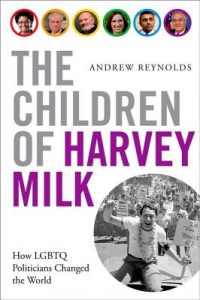 The Children of Harvey Milk: How LGBTQ
The Children of Harvey Milk: How LGBTQ
Politicians Changed the World
by Andrew Reynolds
Oxford University Press
341 pages, $34.95
AS AN ANTIPODEAN reviewer, it’s exciting to read a book that begins with moving descriptions of the votes in the New Zealand and Australian Parliaments to legalize same-sex marriage. The Children of Harvey Milk is refreshingly ambitious in its global scope, even if its examples are almost entirely drawn from the English-speaking world. Andrew Reynolds bases his book on extensive interviews with parliamentarians and legislators, almost all of them British, American, or Irish. To these he adds large amounts of statistical data, so that the book reads as a strange amalgam of journalism and political science, not quite succeeding as either.
Reynolds makes two main arguments. The first is that engaging with people who are “lgbti” is an important factor in changing people’s attitudes. This is a restatement of early gay liberation ideas—“Come Out! Come Out! Wherever you are”—and is hardly controversial, although he provides rich empirical and biographical detail. His second argument relates to his emphasis on the overwhelming importance of individuals: “At its heart,” he writes, “the story of how marriage equality and gay rights advanced in the United States is one of individual agency. Judges, elected officials, and civic leaders move in overlapping social circles.” Political movements seem of little interest to Reynolds, whose focus is entirely on high-profile individuals.
The most striking example of this is a four-page account of Coos Huijsen, who was apparently the first openly gay person elected to a national parliament, namely that of the Netherlands in the 1970s. But nowhere does Reynolds mention that the Netherlands also had one of the strongest early homophile movements in the world, the COC, founded in 1946 and still in existence. Granted, this is a book about parliamentary government, and openly gay politicians do make a difference. But what Reynolds fails to consider is that often such public figures were able to come out only because of long campaigns by social movements and their organizers, who risked far more than revealing their sexuality as a member of the British House of Lords.
At one point Reynolds claims: “The presence of even a small number of openly gay legislators was associated significantly with the future passage of enhanced gay rights.” But the converse is equally true: legal recognition of gay rights makes it more likely that there will be legislators who are open about their sexuality. Thus Reynolds’ own figures, in a comprehensive list of publicly out politicians, shows that they come overwhelmingly from countries that have the greatest acceptance of LGBT rights. The only possible exception is Italy, which has lagged behind the rest of Western Europe in legal recognition of LGBT equality. Other than that, are we surprised that, per capita, Iceland and New Zealand probably top of the list?
There is a commendable attempt to include other parts of the world, but the emphasis on individual parliamentarians means that discussion of what is, after all, the majority of the world’s population is largely reduced to generalizations. There’s a revealing interview with the South African MP Zakhele Mbhele, but it’s included in a chapter that ends by discussing African-Americans in the U.S., a juxtaposition that is tenuous at best.
Reynolds acknowledges there have been occasional openly queer legislators in Japan, Nepal, Hong Kong, and Taiwan, but Asia receives little attention. (The long list of interviewees does include Sunil Pant, the openly gay politician from Nepal, and activist transwoman Bemz Benedito from the Philippines.) Most striking is the lack of discussion of Latin America, which has taken the lead in promoting gay rights within international forums.
There have been comparatively few openly LGBT politicians in Latin America, but given Reynolds’ emphasis on same-sex marriage, he might have reflected on the fact that it was achieved in Mexico City, Argentina, Uruguay, and a number of Brazilian states before it was in the U.S. To explain how this occurred, and why several Latin American countries were advancing LGBT equality against American opposition earlier in the decade, might complicate his triumphalist story about the centrality of “out” politicians.
The strength of the book is the very detailed stories of legislators in the North Atlantic world whom Reynolds interviewed, often providing us with more detail than a reader can assimilate. Do we really need to know the family background of a number of British politicians or read blow-by-blow accounts of primary elections in certain U.S. states? There’s an indulgence toward those he interviews, combined with a strange lack of curiosity about the movements of which they were part.
In the end, The Children of Harvey Milk is an engrossing set of journalistic pieces that shows a remarkable lack of interest in the political movements and cultural changes that created the world in which it is possible to elect openly gay political leaders. Toward the end of his book, Reynolds quotes marriage advocate Evan Wolfson as saying: “The tendency is to think the world began the day you arrived.” If only Reynolds had taken this comment to heart and done more extensive background reading before embarking on yet another cup of tea with British lords.
Dennis Altman’s first book,Homosexual: Oppression and Liberation (1971), is relevant to this review. He is a professorial fellow in human security at La Trobe University.






